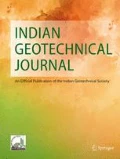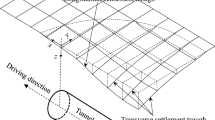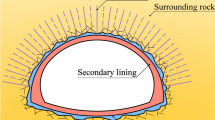Abstract
The settlement induced by the tunneling operation is always threatening the surface buildings structures in urban and residential areas or other underground facilities such as pipelines. Hence, different empirical, analytical, and numerical methods have been used to analyze such a complex problem in which numerous parameters are involved. However, these methods cannot systematically model the interaction between the influencing parameters. The rock engineering systems (RES) is an approach capable of systematic analyzing and modeling of the interacting factors which control the behavior of an engineering system. In this paper, the RES approach was used to investigate the maximum surface settlement (MSS) caused by earth pressure balance (EPB) shield tunneling. Ten parameters influencing MSS were considered, including depth, distance from shaft, ground water level from tunnel invert, average face pressure, average penetrate rate, pitching angle, grouting pressure, grout filling, geology at tunnel crown, and geology at tunnel invert. To establish the model, a database was collected from the construction of Bangkok subway tunnel. The obtained results indicated that RES is a reliable approach for evaluating and estimating MSS caused by EPB shield tunneling for the specified range of influencing parameters.
Similar content being viewed by others
References
Ng CW, Lee K, Tang DK (2004) Three-dimensional numerical investigations of new Austrian tunnelling method (NATM) twin tunnel interactions. Can Geotech J 41(3):523–539
Ou C-Y, Hwang RN, Lai W-J (1998) Surface settlement during shield tunnelling at CH218 in Taipei. Can Geotech J 35(1):159–168
Fang Y, Lin J, Su C (1994) An estimation of ground settlement due to shield tunnelling by the Peck-Fujita method. Can Geotech J 31(3):431–443
Chou W-I, Bobet A (2002) Predictions of ground deformations in shallow tunnels in clay. Tunn Undergr Space Technol 17(1):3–19
Chapman D, Rogers C, Hunt D (2002) Prediction of settlement above closely spaced multiple tunnel constructions in soft ground. In: Proceedings of the 3rd international symposium on the geotechnical aspects of underground construction in soft ground, Toulouse, pp 23–25
Verma AK, Singh T (2010) Assessment of tunnel instability—a numerical approach. Arab J Geosci 3(2):181–192
Ercelebi S, Copur H, Ocak I (2011) Surface settlement predictions for Istanbul Metro tunnels excavated by EPB-TBM. Environ Earth Sci 62(2):357–365
Ocak I, Seker SE (2013) Calculation of surface settlements caused by EPBM tunneling using artificial neural network, SVM, and Gaussian processes. Environ Earth Sci 70(3):1263–1276
Kim CY, Bae G, Hong S, Park C, Moon H, Shin H (2001) Neural network based prediction of ground surface settlements due to tunnelling. Comput Geotech 28(6):517–547
Sou-Sen L, Hsien-Chuang L (2004) Neural-network-based regression model of ground surface settlement induced by deep excavation. Automat Constr 13(3):279–289
Neaupane KM, Adhikari N (2006) Prediction of tunneling-induced ground movement with the multi-layer perceptron. Tunn Undergr Space Technol 21(2):151–159
Santos OJ, Celestino TB (2008) Artificial neural networks analysis of Sao Paulo subway tunnel settlement data. Tunn Undergr Space Technol 23(5):481–491
Suwansawat S, Einstein HH (2006) Artificial neural networks for predicting the maximum surface settlement caused by EPB shield tunneling. Tunn Undergr Space Technol 21(2):133–150
Xu J, Xu Y (2011) Grey correlation-hierarchical analysis for metro-caused settlement. Environ Earth Sci 64(5):1249–1256
Yao B-Z, Yang C-Y, Yao J-B, Sun J (2010) Tunnel surrounding rock displacement prediction using support vector machine. Int J Comput Intell Syst 3(6):843–852
Wang D-D, Qiu G-Q, Xie W-B, Wang Y (2012) Deformation prediction model of surrounding rock based on GA-LSSVM-Markov. Nat Sci 4(02):85
Pourtaghi A, Lotfollahi-Yaghin M (2012) Wavenet ability assessment in comparison to ANN for predicting the maximum surface settlement caused by tunneling. Tunn Undergr Space Technol 28:257–271
Hudson JA (1992) Rock engineering systems: theory and practice. Horwood, Chichester
Faramarzi F, Mansouri H, Ebrahimi Farsangi M (2013) A rock engineering systems based model to predict rock fragmentation by blasting. Int J Rock Mech Min Sci 60:82–94
Benardos A, Kaliampakos D (2004) A methodology for assessing geotechnical hazards for TBM tunnelling—illustrated by the Athens Metro, Greece. Int J Rock Mech Min Sci 41(6):987–999
Shin H-S, Kwon Y-C, Jung Y-S, Bae G-J, Kim Y-G (2009) Methodology for quantitative hazard assessment for tunnel collapses based on case histories in Korea. Int J Rock Mech Min Sci 46(6):1072–1087
Saffari A, Ataei M, Ghanbari K (2013) Applying rock engineering systems (RES) approach to evaluate and classify the coal spontaneous combustion potential in Eastern Alborz coal mines. Int J Min Geo Eng 47(2):115–127
Faramarzi F, Farsangi ME, Mansouri H (2013) An RES-based model for risk assessment and prediction of backbreak in bench blasting. Rock Mech Rock Eng 46(4):877–887
Faramarzi F, Mansouri H, Farsangi MAE (2014) Development of rock engineering systems-based models for flyrock risk analysis and prediction of flyrock distance in surface blasting. Rock Mech Rock Eng 47(4):1291–1306
Fattahi H (2017) Risk assessment and prediction of safety factor for circular failure slope using rock engineering systems. Environ Earth Sci 76(5):224
Fattahi H (2018) An estimation of required rotational torque to operate horizontal directional drilling using rock engineering systems. J Pet Sci Technol 8(1):82–96
Fattahi H (2018) Applying rock engineering systems to evaluate shaft resistance of a pile embedded in rock. Geotech Geol Eng. https://doi.org/10.1007/s10706-018-0536-5
Fattahi H, Moradi A (2017) Risk assessment and estimation of TBM penetration rate using RES-based model. Geotech Geol Eng 35:365–376
Fattahi H, Moradi A (2018) A new approach for estimation of the rock mass deformation modulus: a rock engineering systems-based model. Bull Eng Geol Environ 77(1):363–374
Bahri Najafi A, Saeedi GR, Ebrahimi Farsangi MA (2014) Risk analysis and prediction of out-of-seam dilution in longwall mining. Int J Rock Mech Min Sci 70:115–122
Lu P, Latham J (1994) A continuous quantitative coding approach to the interaction matrix in rock engineering systems based on grey systems approaches. In: Proceedings of 7th international congress of the IAEG, Lisbon, Portugal, pp 4761–4770
Singh T, Kanchan R, Verma A, Saigal K (2005) A comparative study of ANN and neuro-fuzzy for the prediction of dynamic constant of rockmass. J Earth Syst Sci 114(1):75–86
Singh T, Kanchan R, Saigal K, Verma A (2004) Prediction of p-wave velocity and anisotropic property of rock using artificial neural network technique. J Sci Ind Res 63(1):32–38
Author information
Authors and Affiliations
Corresponding author
Rights and permissions
About this article
Cite this article
Fattahi, H., Babanouri, N. RES-Based Model in Evaluation of Surface Settlement Caused by EPB Shield Tunneling. Indian Geotech J 48, 746–752 (2018). https://doi.org/10.1007/s40098-018-0309-3
Received:
Accepted:
Published:
Issue Date:
DOI: https://doi.org/10.1007/s40098-018-0309-3









